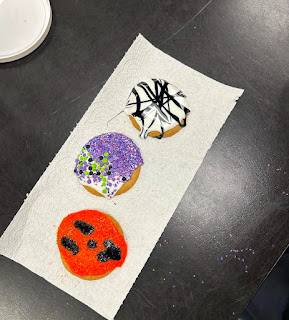Students should hydrate before donating blood, in order to avoid fainting after blood is drawn.
Photo By: Erin King, Photographer
By: Paige Fry, Editor-in-Chief
This school year, four blood drives have been scheduled to visit Seminole High School. Two of the four drives have already collected donations; the next donation at SHS will take place on January 16. One Blood is the company that sends The Big Red Bus to Seminole. Stops from this bus are eight weeks apart because by FDA standards, donors can only donate once every 56 days.
‘Noles have donated 349 pints of blood already this year. Since the 2009-2010 school year, there have been a total of 2,266 pints collected — potentially saving 6,798 lives.
If an individual is willing to donate blood, there are qualifications that must be met before hand: they must be 16 years or older (16-year-olds must have a permission slip signed by a parent or guardian) and must weigh at least 102lbs. People who have had a body piercing, tattoo, any form of cancer, or received a blood transfusion within the last 12 months are not eligible to donate. Those who are pregnant or have recently gave birth, or have visited or lived in the United Kingdom for more than three consecutive months between 1980 and 1996, are also not allowed to donate. There are also a few other reasons why one can’t donate including taking certain medications or having a high heart rate. Each potential donor must also have a form of legal ID with them at the collection location.
If one meets the general qualifications, it is important for them to eat many healthy iron-rich meals, such as spinach or eggs, at least a week before their donation. An hour before drawing blood, a potential donor is advised to eat a substantial meal and drink 16oz of water — this is advised in order to avoid fainting from loss of blood.
Health Academy senior Emily Morales, working at one of Seminole’s blood drives this year, says, “People come in to me to fill out forms for their personal information. After they donate blood, they come back to me and I give them a free t-shirt. You should donate blood to have the self-satisfaction of knowing that you could potentially save someone’s life. My blood type is the universal one, so I thought it would be nice to give blood to everyone.”
For a normal blood donation, one will first have to go through registration which includes signing in, and reading information about donating. Next, a form on health history has to be filled out and a mini-physical will be performed, which will test your blood pressure and iron levels. If the potential donor passes the physical, the donation itself will begin.
The arm will be prepared and cleaned by a One Blood staff member and a brand new sterile needle will be inserted into the prepped arm. After the needle is in place, the donor will sit for around 8-10 minutes while the blood is being drawn. Once the pint is full, the staff member will take out the needle and wrap the arm.
Donating blood “was pretty straight to the point and took less time than I thought it would. [However,] I didn’t expect the needle to be as big as it was or [for the donation to] take as much blood as it did,” says blood donor junior Jefferson Lustre.
The donor is then allowed to wait to leave until they no longer feel dizzy (which is normal). Free drinks and food are provided, and every donor will receive a free t-shirt. Typically, the whole donation process will last an average of 2 hours.
Senior and frequent blood donor Jose Enrique Colon Questell says, “The nurses said that my vein was ‘pretty poppin’, so [the donation] went by pretty quickly. Afterwards, they gave me lots of gatorade and pizza. [Also,] I didn’t pass out, which was good.”
Donors can choose between giving either their blood or only the specific blood transfusable products such as red blood cells, platelets, or plasma. These products can be processed further into other components — for example, cryoprecipitate, an extract rich in a blood-clotting factor, is from plasma.
After the donation is over, the blood is then scanned in a computer database in order to check for blood type, which donors will be able to access through their donor ID number, and for any infectious diseases. One pint of blood could potentially save up to three lives because of the different components drawn from the blood. Red blood cells are stored for up to forty-two days, platelets for up to five days, and plasma for up to one year.
Blood cannot be created chemically, so without donors it would be impossible to save the lives of those in need of blood and blood products. Anyone who meets the basic criteria is eligible to donate if they simply sign up online or Seminole students can find sign up sheets available in the cafeteria, a week before The Big Red Bus makes a stop at SHS.























